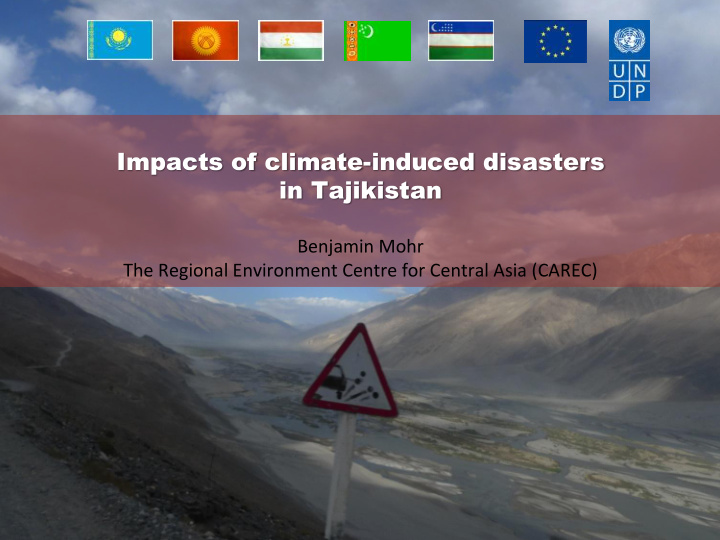



Impacts of climate-induced disasters in Tajikistan Benjamin Mohr The Regional Environment Centre for Central Asia (CAREC)
Tajikistan at a glance • The population of Tajikistan is 8.2 million, > 70 % are living in rural areas • Tajikistan is ranked low in the human development index (0.622 in 2012) and faces a high poverty rate of 47 %; 60 % in rural areas • The climate is semi-arid continental to polar in the mountainous regions • Mountains occupy 93 % of the territory • Agriculture provides 64 % of employment and 21 % of the GDP • Less than 6 % of the land is arable, large parts are effected by erosion and salinization • Despite an adult literacy rate of 100 % the human capital is largely untapped • Labour migration > 1 million
Tajikistan – energy intensity Source: UN ESCAP APEF Portal, BETA version; http://escap.thinkbluedata.com/
Tajikistan – hydropower Source: UN ESCAP APEF Portal, BETA version; http://escap.thinkbluedata.com/
Tajikistan – emissions Source: UN ESCAP APEF Portal, BETA version; http://escap.thinkbluedata.com/
Tajikistan – climate change vulnerability • What to say? The world is not fair…. Tajikistan's contribution to global green house gas emissions is 0.1 % • Despite one of the lowest carbon food print in the world (0.4 t 2 /capita) Tajikistan is considered the most vulnerable country in Central Asia and Eastern Europe Source: Climate change vulnerability index, adapted from the World Bank 2009
Climate change in Tajikistan Within the period of 1940-2007 the air temperature raised for 1-1,5C, especially in plain areas of South and Central Tajikistan
Climate change in Tajikistan Climate models predict an increase of annual mean temperature throughout Tajikistan
Climate change in Tajikistan Glaciers, the source of Central Asian Rivers are decreasing
Climate change in Tajikistan Glacier melt will impact river flow, 22 million people depend on irrigated agriculture in the basin
Varzob, 2004 Khamadoni, 2005 The International Water Conference (June 2008, Dushanbe) highlighted a strong correlation between climate change and more frequent and severe natural disasters. In fact Tajikistan became more susceptible to flash floods, mudflows, droughts, pest outbreaks and forest fire, which are closely interlinked with climate impacts. Shirkent, 2008
Climate induced disasters • The dramatically exposure to climate-induced disasters, have a significant affect on economic development, security and the human capital • Around 500 natural disasters resulting in losses and damages of US$ 200 million every year • Natural disasters have been accountable for 9.5% of the country’s GDP during 1999 -2008. • Mud flows, land slides, floods, erosion and droughts are the main emergencies • Food security, health, glacier melt and degradation of land and forests are major mid / long term impacts • Rural areas faces higher exposure than urban • The most vulnerable groups are: poor, old people, children, woman and single mothers as well as people with disabilities
Role of semi-arid economies Agriculture makes a significant contribution to the national economy: • The agricultural sector accounted for more than one-third of the overall economic growth between 1998 and 2004 • 18% of export revenue is attributable to agriculture, with cotton being the key agricultural export crop • Agriculture is country’s main employer • The majority of the population depend on agriculture for their livelihood: • Agriculture is the platform for improving local livelihoods and tackling poverty • Sustainable agriculture underpins food security: • Gender: Due to migration female and make up the majority of the labour force in agriculture sector, including seasonal employment. • A sustainable and viable agriculture sector is therefore important to female workers and to the cohesion of rural communities
Climate change, water & energy • Water resources are critical for the economic development of Tajikistan, especially for agriculture and energy. • Changes in runoff significantly threaten both sectors and have adverse consequences for the energy and food security, poverty, natural resources and human health. • Climate induced water related disasters are becoming more frequent and severe with a crosscutting impact on all sectors • Floods and landslides reduce the efficiency of hydropower installations and increase the speed of siltation • Energy shortages, known as winter energy crisis, result in deforestation – illegal harvesting for fuel is common, reducing important watershed protection services
Interface between land degradation, agriculture and poverty • There is a close nexus between land degradation and poverty. • Poor rural households in Tajikistan are highly dependent on natural resources and are most affected by environmental degradation, contamination of water sources and by climate induced disasters including droughts, landslides and floods. • Land degradation is a key factor leading to low agricultural productivity and consequently low economic returns and reduced incomes for farmers. • Poor returns trigger migration undermining economic growth • The productivity of the agriculture sector is underpinned by the quality of the land and its availability. • In summary, agricultural output depends on the quality and quantity of land and soils while land degradation imposes significant costs on the economy and hampers poverty reduction and the Tajikistan's adaptive capacity
Gaps and research needs By the first PRISE stakeholder engagement platform : • To close a gap between extreme weather events and their impact on agricultural development and food security • To study sensitivity rather than vulnerability of local communities to climate risks, to support socio-economic development of different target groups • Research on how to close the gap between sectoral adaptation strategies and local adaptation needs; including social aspects, finance and technologies • To involve private sector into adaptation activities and assess opportunities and risks for • To assess the opportunities for value chain financing and community based markets • Research on incentive based natural resource management and adaptation (like PES) • Research on the inclusion of adaptation costs into national environmental accounting
Thank you! Contacts: Mr. Benjamin Mohr Technical Advisor bmohr@carececo.org Ms. Nailya Mustaeva Programme Manager, Climate Change and Sustainable Energy nmustaeva@carececo.org The Regional Environment Centre for Central Asia, CAREC (Almaty, Kazakhstan) www.carecnet.org
Recommend
More recommend